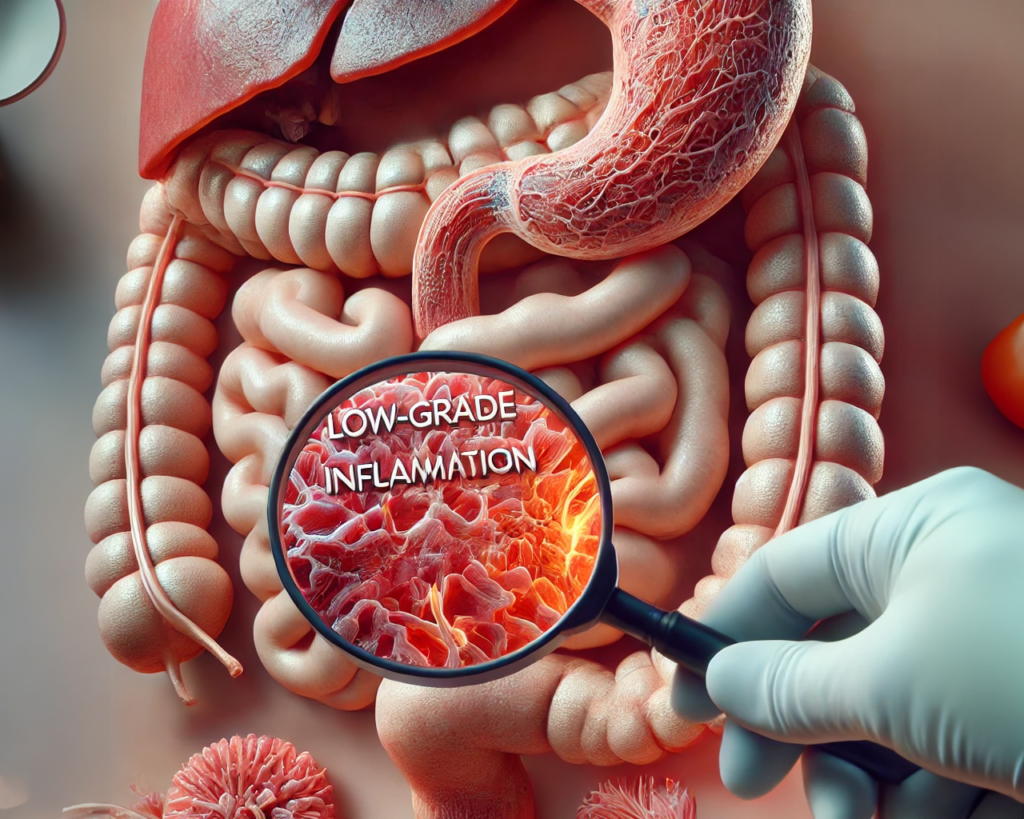Why You Need to Know:
Low-grade inflammation may not produce the pain and swelling of acute inflammation, but its long-term effects can be even worse. For example, if left unchecked, low-grade inflammation can not only lead to various diseases, but also to faster aging and chronic pain. In short, understanding the causes of low-grade inflammation is key for anyone looking to improve their health, longevity, and mental function.
Low-Grade Inflammation: The Silent Threat to Your Health
Low-grade inflammation is a subtle, persistent form of inflammation that operates below the threshold of acute inflammation. Unlike the more intense responses we associate with infections or injuries, low-grade inflammation is steady, and can exist without obvious symptoms.
Hence, while this type of inflammation may not produce immediate pain or swelling, it slowly damages tissues and organs over time, leading to an increased risk for many chronic diseases.
As you may expect, low-grade inflammation is characterized by the ongoing release of inflammatory molecules like C-reactive protein (CRP) and other less known molecules such as interleukin-6 (IL-6), and tumor necrosis factor-alpha (TNF-α) into the bloodstream. Not surprisingly, this is why sometimes we use bloodwork to measure and track CRP as a non-specific marker of inflammation.
Low-grade inflammation is particularly insidious because it affects various systems in the body at the same time without causing noticeable symptoms early on. Over time, this ongoing immune response can disrupt the normal function of vital systems such as the cardiovascular system, the endocrine system, and even the brain.
Causes of Low-Grade Inflammation:
- Poor Diet:
Diets high in refined sugars, trans fats, and processed foods lead to a constant inflammatory state. The consumption of these foods triggers immune responses similar to those caused by infections. - Sedentary Lifestyle:
Lack of physical activity contributes to inflammation by promoting weight gain, particularly the accumulation of visceral fat, which produces inflammatory molecules. - Chronic Stress:
Persistent psychological stress elevates cortisol levels, which can trigger inflammatory processes and disrupt the body’s immune regulation. - Obesity:
Excess fat tissue secretes pro-inflammatory cytokines, which maintain a low-level inflammatory response. - Sleep Deprivation:
In addition, Poor sleep disrupts the body’s ability to regulate inflammation, leading to increased levels of inflammatory markers.
Signs and Symptoms of Low-Grade Inflammation:
- Fatigue:
Low-grade inflammation diverts energy resources, leading to constant feelings of tiredness without a clear cause. - Subtle Digestive Issues:
Not surprisingly, bloating, indigestion, and irregular bowel movements can be linked to inflammation affecting the gut microbiome and digestive processes. - Mild Joint Pain:
While not as severe as in acute inflammation, low-grade inflammation can cause subtle joint stiffness or discomfort, especially after periods of inactivity. - Brain Fog:
Chronic inflammation in the body has been linked to difficulty concentrating and reduced mental clarity, often referred to as “brain fog.” - Elevated Inflammatory Markers:
Blood tests may reveal elevated levels of CRP, IL-6, or other markers of inflammation, even if there are no obvious physical symptoms.
Action Items:
- Adopt an Anti-Inflammatory Diet:
Incorporate whole grains, leafy greens, and omega-3-rich foods (like salmon and flaxseeds) into your diet. Research published in The Lancet shows that a Mediterranean-style diet can reduce inflammatory markers by as much as 30% (Estruch et al., 2013). - Engage in Regular Physical Activity:
Moderate exercise, especially Zone 2 cardio, has been shown to lower inflammatory markers like CRP and TNF-α. A study in the American Journal of Epidemiology found that individuals who exercised regularly had significantly lower levels of chronic inflammation (Waltz et al., 2014). - Prioritize Quality Sleep:
Aiming for 7-9 hours of restful sleep each night can help regulate inflammation. Research in Nature Reviews Immunology found that insufficient sleep raises levels of CRP, worsening low-grade inflammation (Irwin et al., 2016). - Stress Reduction Techniques:
Incorporating stress-reduction practices like yoga, meditation, or deep breathing exercises can lower inflammatory markers. Mindfulness-based stress reduction has been shown to reduce IL-6 levels by up to 25% in people with chronic stress (Creswell et al., 2012). - Limit Processed Foods and Sugars:
Reducing the intake of processed snacks, sugary drinks, and refined carbohydrates can significantly lower inflammatory responses. Studies show that cutting down on processed foods can decrease CRP levels by 20% (Galland, 2010).
Trivia:
Did you know that visceral fat is more dangerous than subcutaneous fat because it surrounds vital organs and actively produces pro-inflammatory cytokines? This hidden fat is often a primary driver of low-grade inflammation.



